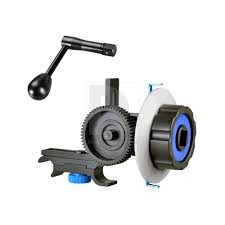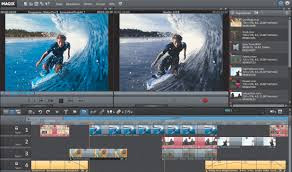A video capable DSLR with a kit lens and a high capacity memory card is all it takes to shoot HD quality video, but if you are serious about shooting motion and aim to produce professional quality movie clips, having the right gear is an absolute must. Here’s a list of accessories designed to make video shooting with DSLR cameras more enjoyable and productive.
1. The Right Camera
 |
| Canon 5d mk iii |
Nikon, Canon, Sony, Pentax, nearly all major manufacturers have introduced video capable DSLRs. The growing popularity of DSLR cameras for video production has prompted manufactures to add additional features like dedicated buttons to improve the video shooting experience in their newer models. Most of these cameras produce identical image quality, however full frame DSLR’s generally outperform cameras with crop sensors in depth of field control and low light shooting abilities. Choose a camera depending upon the kind of work you wish to get done.
2. Choosing The Right Lens
 |
| Camera Lenses |
The kind of lenses required for any project will primarily depend on the nature of the subject you wish to shoot. Prime lenses are the most preferred ones; especially very fast normal lens like the 50mm f/1.8 which produce great image quality for the price. Fast lenses are great for achieving super shallow depth of field and for shooting in very dimly lit situations. Best way to figure out what you need is to do a trial shoot (shoot the intended subject with whatever you have) take note of its limitations and now you know what you need. Additional features like image stabilization are also a great help in eliminating camera shake.
3. Batteries
 |
| Camera Battery |
Shooting video drains batteries very quickly. On an average a fully charged battery will only get you 1.5 hours of shooting time. Consider your shooting requirements and if needed get some spare batteries so you don’t run out of juice before being able to complete the shoot.
4. Memory Cards
 |
| Camera CF Card |
Video is also very demanding on memory, get bigger, faster memory cards to ensure smooth video capture. One way to figure out your memory requirement:- It takes a gigabyte of space to shoot 3 minutes of video. While shooting video you will need to capture plenty of footage from varying angles to give editor more options to narrate the story well. So make sure you always have plenty of extra storage space available. Also faster cards handle the heavy data stream much better and it is also faster to upload your footage from a fast card. Use UDMA compliant cards with speeds of 133x or more. Generally CF cards tend to do better than SD cards. If you are shooting with SD cards, choose a class 10 card, although a class 6 card could also get the job done, a faster card provides many advantages for video shooters. Only drawback of fast memory cards is their hefty price tag, buy the fastest one that fits your budget.
5. Stabilization Solutions
 |
| Steadicam |
Getting a steady shot is often much trickier than it looks when one is shooting video. Every single shift, shake and shudder of the camera will be visible in the video. To help make things easier manufacturers have come up with lots of innovative stabilization solutions for DSLR video shooting.
The greatest accessory for shooting video is undoubtedly a video tripod with a fluid head that provides a lockable tilt function. Another versatile option is the Gorillapod Focus and Ballhead X combination, which allows you to handle your DSLR (along with a hefty zoom lens) in a variety of ways.
For those who do serious video work, consider a dolly (triangular frame with castor-type wheels that mounts on the bottom of the tripod) it makes it convenient to move the camera laterally on smooth surfaces.
6. Viewing Loupe
 |
| Viewing Loupe |
As the mirror stays up during video recording, the view to the viewfinder is blocked and you will be forced to use the LCD on the back of your camera for composing and focusing. This works well indoors and in shade but when working in bright lighting conditions glare can be a big problem not allowing you to see the screen well. A viewing loop will come in handy in such situations, some even magnify the play back and this is helpful to get a better look at the subject for focusing. Also it lets you shoot with the camera held to your eye just like when shooting stills. Many photographers who primarily shoot stills find this very convenient.
7. Focusing Aids
 |
| Follow Focus |
The trickiest part of video shooting is focusing. Without focusing aids you’ll need to focus by turning the focus ring on your lens, this has many limitations and is not very convenient if you wish to move from one focus point to another. Moreover the very act of turning the focus ring will induce camera shake. There are many focusing aids available for DSLR lenses like follow focus which you attach to your lens. Expensive models have gears built in but will only work with certain type of lenses. There are also cheaper, one size fits all solutions. Do try it out and determine whether it’ll fit your equipment and also working style before investing in one.
8. Lighting
 |
| LED Video Light |
Modern DSLR cameras handle high ISOs really well, but in video noise is a big issue and good lighting is the key to great video footage. There are many types of continuous lighting sources available, the most common types are tungsten, fluorescent and led lights, and they all work well for most situations. The big difference is price.
Tungsten Lights
Tungsten lights are perhaps the most commonly used lights in video production; they produce light with a slightly warm tone and also generate a lot of heat. They come in many different sizes and shapes, most popular are lights with a Fresnel attachment which produces a soft beam of light which covers a large area.
Fluorescent Lights
Fluorescent lights are often considered as a cheaper solution to lighting; they produce a cooler, more bluish light and do not generate as much heat as tungsten lights. They usually come in units which have multiple bulbs grouped together in a reflector.
LED Lights
LED lights are the latest addition to video lighting; they produce the same amount of light as other light sources while being more energy efficient and also last much longer. They are also cool to touch and easier to transport as they do not feature any fragile glass bulbs. Currently the only downside is price.
9. ND Filters
 |
| ND Filter |
While shooting video you cannot use shutter speed to control the exposure. You will be forced to set the shutter speed to match your frame rate (double the frame rate) if you use too fast shutter speeds your footage will look jittery and unnatural. So if you wish to keep the aperture constant (for depth of field effects) your only option is to use ND filters in front of your lens to control the amount of light entering the lens. You can either buy neutral density filters of different strengths or buy a variable neutral density filter (in which you control the intensity by rotating the filter) or stack multiple filters.
10. Audio Capture Solutions
 |
| Zoom h4n |
DSLR cameras are great for capturing video, but their audio recording capabilities are pathetic. The built in mic of a DSLR falls way short of professional quality requirements. So the only option is to look for dedicated audio capture solutions.
Dedicated audio recorder
Standalone audio recorders offer more versatility than on camera microphone. It allows you to place the recording device any place (independent of camera location). They are also a bit more customizable; however you’ll need to sync the audio with your video later in post.
Shotgun Microphone
Shotgun microphone is tethered to the camera and records directly into the camera. They are usually mounted on the hot shoe and works as a replacement for the built in mic. Although it provides significantly better audio than the built in mic it does have its share of limitations. Firstly it needs to be tethered to the camera so you don’t have the kind of flexibility to place it anywhere like a standalone audio recorder. Secondly it could be very directional so you’ll get good audio from what’s directly in front of you but not from sides. Thirdly the sound might change as the camera moves around.
Lavalier microphone
Lavalier microphones are attached directly to a person and provide best quality when recording someone’s voice, great for documentary style interviews.
11. Video Editing Software
 |
| Video Editing Software |
Editing video can be both simple and complex depending on what you intend to achieve. Basic functionalities are easy enough to master but once you try advanced editing the amount of complexity is mind blowing. Don’t jump headlong into pro editing softwares, instead start with some simple solution and as you edit you’ll know whether or not you need more advanced editing softwares.
Post a Comment